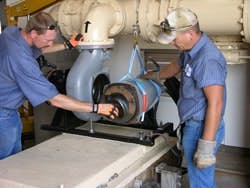Texas WWTP Meets Challenges Imposed by Stringent Regulations
For some wastewater treatment plants, the addition of secondary treatment and related upgrades present few problems, but for a facility in Vernon, Texas, the changes proved to be challenging. The Vernon plant had to adjust to increasingly stringent regulations, industrial load and brine with nitrates off the city's recent Ion Exchange water treatment plant. The plant's performance relies equally on the resourceful staff and technologies to operate in compliance.
"Keeping the microorganisms in balance is an ongoing challenge here," said Donnie Higgins, the plant supervisor who has worked at the facility for 18 years. "We have to keep our mixed liquor balanced at 1100 mils/per liter to maintain an efficient aerobic process. Any higher than that and we experience a high die off rate. Most other plants typically run in the range of 2,000 to 4,000 mil/per liter, even though we waste out about the same."
Upgrades and modifications
Vernon built the 2 mgd WWTP in the 1950s, which is now a 60-acre facility that discharges into the adjacent Pease River. Several major upgrades and process modifications altered the plant in the mid-1980s and again in the mid-1990s in response to regulatory mandates. The upgrades aimed at improving the operating parameters.
At that stage, four 15-hp Flygt pumps with VFDs pump it to an aeration basin, and from there is channeled through a splitter box that sends flow through two secondary clarifiers. Sludge from the bottom of these secondaries is part return activated sludge (RAS) used to reseed the process. Waste activated sludge (WAS) advances into the thickener before being pumped to the digester. The clean, clear water advances through sand filters ahead of the UV system and then through a flow-measuring device and into the discharge line.
The sludge, containing approximately 5% solids, from the primary digester and thickener is advanced to the sludge digester where it recirculates through a boiler that keeps the digester at a constant 95° F. After passing through a belt press, the compressed cake is collected and the byproduct water captured and sent back to the influent. The cake has been sent to a landfill since the utility abandoned land application in 1996.
Equipment reliability is essential to the operation. Prior to a recent upgrade, the digester recirculating pump proved particularly problematic. The belt-driven, 8-in. unit had been a chronic—and costly—problem.
“The pump failed up to eight times a year, which would paralyze the process flow for several days pending repairs. It could cost us up to $2,000 to repair the pump even if we did the work ourselves," said Higgins. “Repairing this pump was always a major project. It would cost us $6,000 just for the parts to completely rebuild it.”
Upgrading the pump
Higgins decided to upgrade the sludge recirculating pump to an ITT Flygt Model NZ3153 after learning that the company’s well-known submersible pumps could be configured to operate in a dry well mode.
"Reliability was the major reason for selecting the digester recirculating pump from ITT Flygt," said Higgins. "Flygt had supplied three two-speed pumps in our main influent pit, four at the racetrack and others in lift stations. They never had given us any problems and had been easy to work on and maintain."
The digester pump has been operating flawlessly since being installed at the plant's dry pit.
"We've never had to pull it for a clogged impeller," added Higgins. "And have never been off line since."
